Nancy Bilyeau's Blog, page 2
October 17, 2023
My Tudor Novels The Crown and The Chalice, Part Two!
My 2012 debut novel, The Crown, was set in Tudor-era England with a Dominican novice, Joanna Stafford, as the protagonist. The historical thriller found readers in the United States and United Kingdom as well as other markets worldwide, from Germany to Spain to Russia. I followed it with The Chalice and, finally, The Tapestry.
I'm pleased to report that Orion Publishing, the respected house that put out my Joanna Stafford novels in the UK and Australia, is publishing The Crown and The Chalice with new covers to bring them to the attention of readers who might not have discovered the novels the first time.
Aren't these covers fantastic?

When The Crown first came out, it was dubbed by Oprah magazine "the Page-Turner You'll Tear Through." The review said: "Bilyeau deftly weaves extensive historical detail throughout, but the real draw of this suspenseful novel is its juicy blend of lust, murder, conspiracy, and betrayal."
Authors who endorsed the book included:
Alison Weir: “A stunning debut. One of the best historical novels I have ever read.”
Deborah Harkness: "Nancy Bilyeau's polished, inventive debut has all the ingredients of the best historical fiction: a broad cast of characters, well-imagined settings, and vivid story-telling. . . . In Joanna Stafford, Bilyeau has given us a memorable character who is prepared to risk her life to save what she most values, while Stafford's desperate search for a lost religious relic will satisfy even the most ardent mystery fans."
As for The Chalice, it won the Romantic Times Award for Best Historical Mystery and was praised by Parade: “English history buffs and mystery fans alike will revel in Nancy Bilyeau's richly detailed sequel to The Crown.”
You can pre-order The Crown as a paperback here and The Chalice paperback here. This is for the UK market only.
In America, the novels with their original covers are very much on sale. I still get royalties every year for The Crown! You can find them in paperback, hardback, and ebook here.
I loved writing these books and hope new readers will discover Sister Joanna...
September 22, 2023
Publisher Discount for The Orchid Hour
For the next week, my historical novel The Orchid Hour will be priced at 99 cents for the ebook in the United States and the United Kingdom.
To order it, click here.

I'm thrilled with the response to my novel!
Publishers Weekly gave it a starred review and said: "Bilyeau paints a vivid portrait of 1923 New York City—particularly its insular Italian community, alluring speakeasies, and Prohibition-fueled organized crime—in this impeccably researched historical mystery...brilliantly evokes the intoxicating grit and glamour of Jazz Age Manhattan and layers a smooth blend of suspense and romance on top. Historical mystery fans will find this irresistible."
On Amazon, The Orchid Hour has a 4.4 rating among readers.
The endorsements from other authors include:
"With a heroine you can’t help rooting for, a fascinating cast of characters, and a tense, high-
stakes mystery at its heart, this is a book you can’t stop reading." -- Olivia Hawker, bestselling author of One for the Blackbird, One for the Crow
“Nancy Bilyeau draws you effortlessly into a layered story, rich in historical detail, with a strong, intelligent, determined heroine at its center. I loved Zia from page one.” – Barbara Claypole White, author of The Perfect Son
“The structure of the story races you through it at breakneck speed. It is a hard book to put down, and all the time, there are so many threads binding the story together that the story is like an orchid and its roots.” – Griff Hosker, author of Hastings, Flodden, and Lord Edward’s Archer series
“Nancy Bilyeau has created a beautifully layered and utterly seductive tale of a young woman’s emotional awakening and search for justice, set against the dangerous criminal world of the 1920s New York City underground. The past comes thrillingly alive as Bilyeau lifts the veil on immigrant communities, speakeasies, gangsters, corruption at the highest levels of city government, and, at its living, tender heart, a strong-willed and magnetic heroine.”
—Emilya Naymark, author of Behind the Lie, finalist for the 2023 Sue Grafton Award
"The Orchid Hour... reeks with the smell of lasagna in Little Italy, the smell of cheap gin in a 1920s speakeasy, and most importantly and most delicately with the scent of orchids at midnight... her best by far, and she'd already set a high bar." - Timothy Miller, author of The Strange Case of Eliza Doolittle
"Nancy Bilyeau has become my go-to author for brilliantly written historical suspense... Read it and be seduced." - Kris Waldherr, author of Unnatural Creatures and The Lost History of Dreams
It has a 4.4 reader rating right now on Amazon.
September 12, 2023
Guest Post: Crystal King's Renaissance Recipe & Book Giveaway

Hi all!
Like Nancy, I also write historical fiction. Ihave focused on historical chefs and Italian culinary figures who left behindcookbooks or manuals of stewardship that laid the foundation of the Italiancuisine we know and love today. My most recent novel, The Chef’s Secret, is about the first celebrity chef, Bartolomeo Scappi,known throughout Italy and possibly all of Europe for his grand banquets. Hiscookbook, L’Opera of Bartolomeo Scappi, contains over 1,000 recipes, including some of the firstpasta dishes, hundreds of meat and fish recipes, and dozens upon dozens ofdelicious recipes for pies and pastries. It was published in 1577 and was abestseller for nearly two centuries.
I love writing about Italian culinary figures(my first novel, Feastof Sorrow, was about Apicius, an ancient Romangourmand), and with that comes the opportunity to dive deep into thesehistorical cookbooks to recreate the meals of the past.
Today I’m sharing a recipe from Book V.148of L’Opera di Bartolomeo Scappi. You may have heard thatbagels originated with Polish Jews in the 17th century, but in Italy, ciambelle hadbeen around for at least a century or two before. A ciambella isessentially a form of what we know as a bagel, dough that is boiled and thenbaked, and, by the 1600s, ciambelle vendors were common on thestreets of many Italian cities. Ciambelle are still popular inItaly today, and many Italian American households will recognize a version ofthis recipe or the very similar but much harder, taralli, as astaple at their table. You’ll also see the term ciambelle torefer to sweet ring-shaped cookies or cakes, which emerged over thecenturies.
It was common to see ciambelle venditore onfoot, such as this seller, who carried the crunchy but soft rounds of bread onsticks in his basket.

This recipe tries to stay true to Scappi’s but,to give it a little oomph, I did include yeast. If you’re not a fan or can’tfind any, you can leave out the rosewater and use plain water, but you’ll losethe distinct Renaissance flavor.
Ciambelle
Note: Whenbuying rose water, make sure that you are not buying rose essence, which mightbe labeled as rose water but comes in a brown bottle. Buy clear tall bottles ofrose water such as Cortas or Al Wadi.
Makes 8 large (6 inch) ciambelle
4 c. flour
1 packet of active dry yeast
¼ cup and 1 tbsp sugar
2 tsp rosewater
1 ¼ cup goat milk (or substitute wholemilk)
2 beaten eggs
1 tbsp anise or fennel seeds
1/2 tsp salt
These are best eaten right away but will keep in anairtight container for a week, or you can freeze them and they will keep for amonth.

Doesn’t this sound scrumptious? If you wouldlike a giveaway paperback of The Chef’s Secret, please email me at tudorscribe@gmail.com, and I will pick a winner.Crystal will mail the book to your home.
And put Crystal's next novel onyour radar: In the Garden of Monsters, pitched as a Gothicretelling of the myth of Hades and Persephone, coming in 2024.
August 10, 2023
My Jazz Age Novel Is on Sale Today!
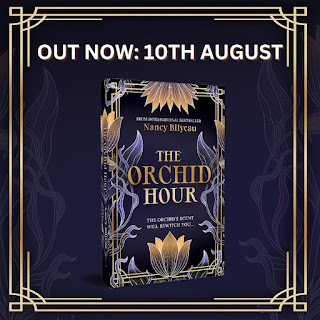
Now the story can be enjoyed as a paperback, an ebook, or an audiobook in the US, the UK, Canada, and Australia.
The Amazon link is here.
For other links, go here.
—Publishers Weekly, Starred Review
"A gloriously heady and intimate tale of love, loss, and family, set within one of the most fascinating periods of the 20th century." -- LoveReadingUK
Featured in Town and Country‘s “Must-Read Books of Summer 2023”
"From the family shops of Little Italy to the bright lights of Dreamland, Nancy Bilyeau takes you on a glittering tour of a bygone New York… " – Mariah Fredericks, author of The Lindbergh Nanny
"This is a novel redolent with sensuality, intrigue, and suspense. If you like Agatha Christie, you will love The Orchid Hour." -- Paulette Kennedy, author of Parting the Veil and The Witch of Tin Mountain
'Nancy Bilyeau has created a beautifully layered and utterly seductive tale… and, at its living, tender heart, a strong-willed and magnetic heroine.' – Emilya Naymark, author of Behind the Lie, finalist for the 2023 Sue Grafton Award
"Evokes the Jazz Age at its hottest" --Richie Narvaez, author of Hipster Death Rattle
"Nancy Bilyeau has become my go-to author for brilliantly written historical suspense... Read it and be seduced." - Kris Waldherr, author of Unnatural Creatures and The Lost History of Dreams
With a heroine you can’t help rooting for, a fascinating cast of characters, and a tense, high-stakes mystery at its heart, this is a book you can’t stop reading.' – Olivia Hawker, bestselling author of One for the Blackbird, One for the Crow
'The Orchid Hour… reeks with the smell of lasagna in Little Italy, the smell of cheap gin in a 1920s speakeasy, and most importantly and most delicately with the scent of orchids at midnight… her best by far, and she’d already set a high bar.' – Timothy Miller, author of The Strange Case of Eliza Doolittle
August 9, 2023
The Hidden Street I Chose for The Orchid Hour
And now I’d like to take you behind the scenes of my writing process and explain my choice of a location for my fictional nightclub, The Orchid Hour. Some of the best-known clubs of the Roaring Twenties were either in midtown (The El Fey Club) or Harlem (The Cotton Club). I contributed a guest post to author Tony Riche’s blog on Times Square of the 1920s. Read it here.
But in certain ways, I wanted to model my nightclub on Chumley’s, a real-life speakeasy in the West Village. While it was favored by literary stars like Dorothy Parker, Edna St. Vincent Millay, and Eugene O’Neill, it was carefully hidden. Its Barrow Street entrance was located at the end of a nondescript courtyard, and the Bedford Street entrance to Chumley’s was an unmarked door. After all, the whole point was to hide their drinking from the police!
For The Orchid Hour, I wanted to pick a place closer to the main part of Greenwich Village but on a little-known street. So I settled on MacDougal Alley. It’s a cul-de-sac that runs east off MacDougal Street in the block between West 8th Street and Waverly Place. People who love Greenwich Village history cherish MacDougal Alley.
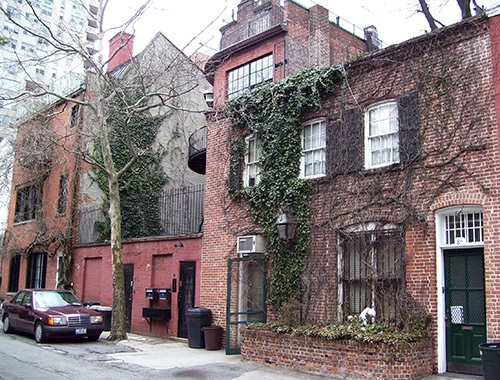
Named after a Scotsman who was a hero of the Revolutionary War, the alley was home to the stables for the great townhouses along Washington Square North beginning in the 1830s. Despite its proximity to people who would have felt comfortable in a Henry James novel, the alley was in an area considered unsafe. The newspapers complained that this part of the city was “in the nighttime infested with base and unprincipled persons, who take advantage of the darkness in consequence of the dense foliage of the trees and the dimness of the ordinary street oil lamps to perpetrate acts of violence.” When gas lamps were installed in 1849, there was some relief.
MacDougal Alley is technically a “mews,” which means it’s a row or street of houses or apartments that have been converted from stables. Around the time that horses were replaced by automobiles, MacDougal Alley became a beacon to artists, perhaps drawn by the ivy-covered brick walls and the gas lamps. Many of the buildings were turned into artists’ studios.
Here are just a few of the people who lived off MacDougal Alley:Gertrude Vanderbilt Whitney, who founded the Whitney Museum of American Art, had a studio on the alley, prompting horrified headlines such as "Daughter of Cornelius Vanderbilt Will Live in Dingy New York Alley.”A beautiful artist’s model and silent film actress named Audrey Marie Munson dubbed “American Venus” lived there around 1915. As one newspaper put it: “ ‘Venus of MacDougal Alley,’ Whose Beauty Is Embalmed in a Thousand Sculptures.” Later a man would murder his wife in hopes of marrying Munson and that dimmed her career.Isamu Noguchi, after a stay in a Japanese internment camp in Arizona, moved to a home and studio number 33. Some of his best-known works, a series of interlocking sculptures begun in 1944, were created here. From 1949 to 1950, Jackson Pollock lived at number 9.
 Audrey Marie Munson
Audrey Marie Munson
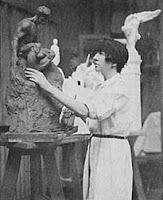 Gertrude Whitney in studio
Gertrude Whitney in studioWhat’s MacDougal Alley like now? The cobblestones were paved over, and at some point it became a private street, locked to the public, although you can peer through the gates and see its charm. The homes are very expensive. One of the properties sold for $5 million in 2009. I must admit that whenever I wander past, I hope that someone will take note of my interest and beckon.
My novel The Orchid Hour will be published on August 10th.
 I stopped for a peek March 2023
I stopped for a peek March 2023 MacDougal Alley
MacDougal AlleyAugust 2, 2023
Review of the Medieval Historical Novel "Hastings"
Hastings, by Griff Hosker
Review by Nancy Bilyeau
Like many other people, I have always perceivedWilliam the Conqueror and his Norman army as a menacing and relentless invadingforce that squashed the Saxons through overwhelming brute force rather than followingup on a legal right to succession.
Griff Hosker’s novel Hastings at first glance, maylook like an interesting take on the traditional view of 1066. It is subtitled “Conquest:Book 1” with the cover message “The Battle That Changed Everything.” This is abook coming to 1066 from a Norman perspective.
I knew that with Hosker, I would get a deeply researched andauthentic medieval-age story. He has written historical novels spanning theRoman era to World War II, with my favorite series being the Lord Edward’sArcher books set in 13th-century Wales and England.
What I wasn’t ready for in Hastings were the emotionalstakes of the story, which soon captured me. The protagonist, Richard fitzMalet, is a man with a complicated family background living in a complicated time of constantly shifting alliances. His father was a Normanknight, Lord Robert Malet, but his mother was English. She was the young daughterof an English housecarl, a bodyguard who served Lord Robert when he came toEngland. Seduced and swiftly discarded, she gave birth to an illegitimate sonthat the Norman family reluctantly raises, but at a distance.
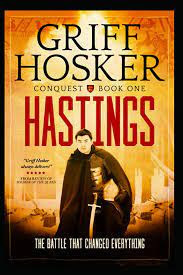
There are enormous tensions springing from the circumstancesof Richard’s birth. His grandfather resents the seduction of his daughter,which ruined her for marriage and broke her health, leading to an early death.Richard learns conversational English from his grandfather, the only lovingfamily he has, which will prove crucial in later chapters. As his grandfather isresponsible for teaching warrior skills and weaponry handling to the boys ofthe large household, he pays special attention to the training of his grandson.As he tells Richard, the Normans see the English as inferior and Richard isintended to live as a bodyguard of his half-brothers, inherently disposable. Heneeds the finest warrior skills obtainable in order to stay alive.
“Thanks to my grandfather, I never felt myself a Norman,”Richard tells the reader. But throughout his childhood and young manhood, he absorbsNorman standards of manhood and strengths in warfare. He respects those strengths,which made the Normans a feared group throughout Europe. However, his emotionalloyalty is to his grandfather and the friends he makes himself, and later towarriors who go out of their way to look out for him, as opposed to seeing himas nothing but a human shield.
There is a great deal of tense and absorbing drama inRichard’s changing position as he slowly transforms from ignored bastard sonof an obscure English girl to a formidable warrior. The Malet family is not whollyproud of those skills, especially his nasty half-brother Durand. Because Richardis not one of the “important” legitimate brothers, and these knights, squires,and housecarls often plunge into deadly conflicts, it’s by no means a certaintyto the reader that Richard will escape from any encounter unscathed.
In these encounters, Hosker’s ability to describe battles--boththe “big picture” and the reality of up-close fighting between men grimly tryingto kill each other—really shines. He knows every detail of the weapons andarmory. Those curious about William the Conqueror will find fascinatingdescriptions of his court and his trips to England with Richard in his retinue.These trips were diplomatic for the most part, and I was surprised by how closehe was to the childless King Edward. Duke William’s claim to succeed to theEnglish throne is outlined well.
Richard fitz Malet is more than a proficient warrior and a feared athletic combatant in a time of fierce war. He is someone of deep loyalty.While he has a good heart, there is a simmering bitterness inside Richard. I ameager to see where the next novels in Hosker’s series take this engagingprotagonist.
To learn more about Hosker, go here: https://www.griffhosker.com/
Hastings on amazon: https://www.amazon.com/Hastings-Conquest-Book-Griff-Hosker-ebook/dp/B0C1NMYX78/
July 24, 2023
A Goodreads Giveaway of The Orchid Hour
From July 15 to July 31, Goodreads is offering a giveaway of my historical novel, THE ORCHID HOUR. Twenty ebooks will be given away to the winners.
To enter the Goodreads giveaway, click here.

'With a heroine you can’t help rooting for, a fascinating cast of characters, and a tense, high-stakes mystery at its heart, this is a book you can’t stop reading.' – Olivia Hawker, bestselling author of One for the Blackbird, One for the Crow
'From the family shops of Little Italy to the bright lights of Dreamland, Nancy Bilyeau takes you on a glittering tour of a bygone New York…' – Mariah Fredericks, author of The Lindbergh Nanny
And Publishers Weekly gave the novel a starred review:
Bilyeau (The Fugitive Colors) paints a vivid portrait of 1923 New York City—particularly its insular Italian community, alluring speakeasies, and Prohibition-fueled organized crime—in this impeccably researched historical mystery. Zia De Luca, a 26-year-old widow, lives a dreary life with her in-laws and young son in Little Italy while working as a translator for a branch of the New York Public Library. Shortly after she’s asked by deputy mayor Miles G. Watkins to translate a play by Sicilian author Luigi Pirandello, Watkins is gunned down on the library steps. Due to her recent contact with the politician, Zia becomes NYPD Lt. Frank Hudgins’s primary person of interest in the murder. After a second killing much closer to her home, Zia begins to suspect that the crimes are connected to a mysterious Greenwich Village speakeasy called the Orchid Hour. Seeking answers, she starts hanging around the establishment, eventually falling in love with an employee and tasting her first morsels of happiness since her husband died. Alternating perspectives between Zia, Hudgins, and a mob stooge named Louis, Bilyeau brilliantly evokes the intoxicating grit and glamour of Jazz Age Manhattan and layers a smooth blend of suspense and romance on top. Historical mystery fans will find this irresistible. (Aug.)
The Orchid Hour will be published on August 10th!
March 8, 2023
'The Orchid Hour' Can Be Read on NetGalley
You can find The Orchid Hour here.

Here's the latest review:
"I needed this book as a New Yorker in this post-pandemic world because NYC was, and always will be, heaven on earth. Five out of five stars, as a NYC, murder mystery, and historical fiction lover. From a New Yorker’s perspective, this book is spot on when describing New York City and its famous neighborhoods, love that! The roaring jazz age of the 20’s feels like a fresh timeline when reading historical fiction. I fell in love with the main character Audenzia, right from the start. And I love libraries! So these four things made the book unputdownable for me! It was a slow burn for the first 3 chapters, and by chapter four, the tension was fast-building. My heart was in my throat as the danger got worse, but the book made me smile too, as the Italian accents were perfect. It made the story suspenseful and fun at the same time. I didn’t know what it was like to live in NYC in the 20’s, so I learned a bit as well. The danger and racism at that time was captivating to read about. Watkin’s and Audenzia’s friendship was a joy (and sad) to see develop. The book really pulled together all the many, many details about this murder mystery at the end, it left me very sad when the book was finished, not because of the ending (which was awesome!) but because I wanted the story to go on and on. For me, it was a perfect historical mystery with excellent character development. Thanks to Lume Books and NetGalley for this ARC. I volunteered to read it and give my honest opinions. #TheOrchidHour #NetGalley"
February 15, 2023
My Historical Novel "The Orchid Hour": On Pre-Order Now
I'm happy to present the cover of my new historical novel, THE ORCHID HOUR. It will be published in ebook and original paperback on August 10, 2023. It can be pre-ordered on amazon now. Click here.
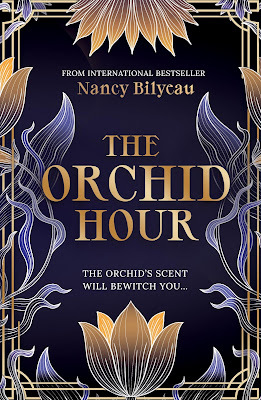
There is a certain hour, in the dead of night, when the orchid’s scent can put you under a spell…
"Nancy Bilyeau has created a beautifully layered and utterly seductive tale… and, at its living, tender heart, a strong-willed and magnetic heroine." – Emilya Naymark, author of Behind the Lie, finalist for the 2023 Sue Grafton Award
__________
In Little Italy, New York, during the heady atmosphere of the Roaring Twenties, a young widow named Zia De Luca finds herself at the center of a murder investigation. Searching for answers, Zia enters the shadowy underworld of speakeasy The Orchid Hour. But to bring the killer to justice, she’ll have to beat notorious racketeers Arnold Rothstein and Lucky Luciano at their own game.
__________
Nancy Bilyeau, author of The Blue, returns with a tantalizing novel about one woman caught up in a secret nightclub that one can only reach through a certain florist on a cobblestone street.
New York City, 1923. Zia De Luca’s life is about to be shattered. Having lost her husband to The Great War, she lives with her son and in-laws in Little Italy and works at the public library. But when a quiet poetry lover is murdered outside the library, the police investigation focuses on Zia. After a second tragedy strikes even closer to home, Zia learns that both crimes are connected to a new speakeasy in Greenwich Village called The Orchid Hour.
When the police investigation stalls, Zia decides to find her own answers. A cousin with whom she has a special bond serves as a guide to the shadow realm of The Orchid Hour, a world filled with enticements Zia has shunned up to now. She must contend with a group of players determined to find wealth and power in New York on their own terms. In this heady atmosphere, Zia begins to wonder if she too could rewrite her life’s rules. As she’s pulled in deeper and deeper, will Zia be able to bring the killers to justice before they learn her secret?
Available in paperback and ebook in the UK, the US, Canada and Australia. Preorder here.
December 21, 2022
When January 1st Wasn't the First Day of the Year
In less than two weeks it will be the first day of 2023. Time to hang your freshly bought calendars and write a new year on your checks.
But strange as it may seem, January 1st did not always signal the beginning of a new calendar year. Up to 1752, the two were separate things in England and its colonies. Until that point, people began each calendar year on March 25, which was Annunciation Day—or Lady Day. This was the day the Angel Gabriel appeared to the Virgin Mary to deliver the news that she had conceived and would give birth to Jesus in nine months. It took an 18th century act of Parliament for England to officially begin each new calendar year on January 1st. The centuries of discrepancy caused lots of headaches for historians and genealogists. There’s no question that it’s strange, not least because England lagged behind much of the rest of Western Europe. Why did this Protestant nation cling to Annunciation Day—by its very definition a day revolving around the Virgin—as the time to change the calendar when most Catholic countries had already shifted to January 1st in the 16th century or 17th century?
It took an 18th century act of Parliament for England to officially begin each new calendar year on January 1st. The centuries of discrepancy caused lots of headaches for historians and genealogists. There’s no question that it’s strange, not least because England lagged behind much of the rest of Western Europe. Why did this Protestant nation cling to Annunciation Day—by its very definition a day revolving around the Virgin—as the time to change the calendar when most Catholic countries had already shifted to January 1st in the 16th century or 17th century?
The reason for the January 1st controversy has a lot to do with England’s refusal to take orders from a pope after Henry VIII’s break from Rome in the 1530s. It was Pope Gregory XIII who replaced Julius Caesar’s calendar, devised in 45 BC, with a new one in 1582—and it’s the Gregorian calendar we all use today. Reform was unquestionably needed. There were too many days in the year; the equinoxes were out of whack; the Julian calendar had strayed 10 days from the solar calendar.
Among other things, the pope’s new calendar established that each calendar year begin on January 1st. Once it was issued, Italy, Spain and Portugal instantly adopted the Gregorian calendar, followed by France and the other Catholic countries of Europe. But England, Germany and the Netherlands refused. So for centuries, there were two calendars in Western Europe. It wasn't a strictly religious-led decision either. In Protestant Scotland, they changed to the Gregorian calendar in 1600. But England stubbornly refused.
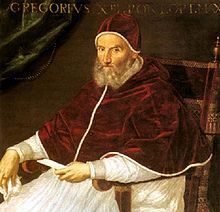
The first step to understanding this furor is to realize that Pope Gregory XIII was not simply someone who cared about calendars. Born in Bologna as Ugo Buoncompagno, he was a transitional pope. Certainly not as venal and corrupt as the Borgias a century earlier, he was a gifted teacher and administrative talent who nonetheless had an illegitimate son before marrying and really liked to spend money.
Once he became Gregory XIII, he spent huge sums on not only Catholic colleges but also displays such as the Gregorian Chapel in St. Peter’s. To pay for all this, he resorted to papal confiscation. Most relevant to our story, he supported the overthrow of Henry VIII’s Protestant daughter with Queen Anne Boleyn, Elizabeth I.

Gregory’s predecessor, Pope Pius V, had already excommunicated Elizabeth and declared her a usurper in 1570. During his papal office, Gregory put intense pressure on the Spanish king, Philip II, to invade and dethrone England’s queen. Gregory personally financed an armed force of 800 men to land in Ireland to join a Catholic rebellion against Elizabeth (it fizzled). Moreover, a Jesuit led the papal commission to devise the Gregorian calendar—and the Jesuits were the religious order specifically created to fight the Protestant Reformation. This all fueled Elizabethan England’s refusal to accept anything that originated in the Vatican.
The fierce clashes between Catholic and Protestant in the 16th century are the tumultuous background of my historical thrillers. The heroine of my novels, The Crown, The Chalice, and The Tapestry, is a novice in the Dominican Order at Dartford Priory, outside London. But it’s not just the Christian splintering in early modern Europe that fascinates me. I also love studying what came long before the Renaissance.
One October, as Halloween approached, I researched the roots of the holiday’s celebration in Tudor England and made some discoveries. I learned that the roots of Halloween reach back to the Dark Ages Celtic festival of Samhain (“summer’s end”), when people lit bonfires and put on costumes to scare away the spirits of the unfriendly dead. All-Hallows-Even, which was shortened to “Halloween” in the 16th century, was a complex blend of Celtic and Catholic customs. After all, the holiday was the run-up to All Saints’ Day on November 1st, an occasion to venerate all the Catholic martyrs. Not surprisingly, the Protestant Reformers took a dim view of Halloween, but its popularity was so great that they were unable to stamp it out.
My blog post on Halloween stirred up so much attention that it made me want to keep reading about the distant and complex roots of what we celebrate today.
I began thinking about the origins of Christmas and New Year’s Day the morning of December 20th one year, when I stood outside my apartment building with my son, waiting for his school bus to arrive. Although it was 7:15 a.m., dawn had barely broken; the Christmas lights that the superintendent had strung over the bushes glowed yellow in the purplish-gray light. A hazy fullness hung in the air—and it seemed to carry a strange potency. Almost like something magical. I had no idea as I stood there that what I sensed would connect to January 1st and the fascinating furor over when to begin the calendar year.
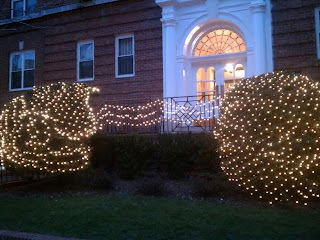
I snapped a photo and posted it on my Facebook page, along with sharing a description of the strange feeling all around me. A high school friend, D.K. Carlson, offered an explanation: “The solstice is almost here.” It made me shiver to think it was the power of the winter solstice that touched me that morning: the approach of the shortest day of the year, the moment when the earth is in a point of its orbit farthest away from the sun. I find it very interesting that Julius Caesar established December 25th as the date of the winter solstice. It was—you guessed it—Pope Gregory XIII who made the adjustment to December 21st.
Long before the time of Julius Caesar, man honored the solstice. Bronze Age archaeologists have uncovered symbols and signs that reveal awareness of the shortest day of the year. The monuments of Stonehenge and Newgrange in Ireland are believed to have solstice alignments. In 2000 BC, people may have gathered at Stonehenge in mid-December to pray for the sun to return again, the source of all life.

Again and again, in many societies and religions, the solstice has great meaning. For the Druids, it was Alban Arthuan, the Light of Winter. As part of the celebration, priests cut the mistletoe that grew on winter oaks and blessed it. Germanic pagans launched the tradition of burning the Yule log and decorating a home with clippings of evergreen trees.
In Rome, not surprisingly, the celebrations became more debauched. Saturnalia, which took place in mid-December, ran the gamut from heavy drinking to gambling to reversing society norms, with masters waiting on slaves. Lighting candles was very important. So was the tradition of children going house to house, offering small gifts, such as wrapped fruit, in exchange for other tokens.
Saturnalia was so popular that not even the Fall of Rome could kill it. It morphed into the Feast of Fools, celebrated from the Fifth Century until the Renaissance in much of Western Europe on January 1st. The servants became the masters, with a lower-echelon “Lord of Misrule” chosen to preside over all drunken festivities beginning in late December and concluding on the first of January.
Not surprisingly, the early Catholic Church did not look kindly on the parties--stimulated by the winter solstice--that marked January 1st. The church leaders didn’t want something as important as beginning a new year to take place on that same day. In 567 AD, a Council of Tours decreed that the first of January was abolished and the blameless Annunciation Day was chosen. It took a while for this to be accepted, but by medieval times, people in England looked on March 25th as the beginning of the year. And this tradition stuck through the Plantagenets, the Tudors, the Stuarts, and into the time of the Hanoverians.

Until finally, in 1751, in the reign of George II, England—and its colonies in the Americas—gave in and made the change, moving from the Julian Calendar to the Gregorian. Parliament passed An Act for Regulating the Commencement of the Year; and for Correcting the Calendar now in Use. To make this work, 16 days were dropped from 1751, and January 1, 1752 was officially deemed the beginning of the year.



